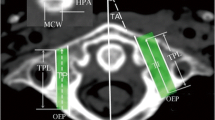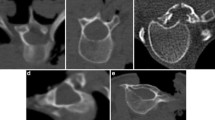Abstract
Purpose
The objective of this study was to investigate the optimal entry point and pedicle camber angle for L5 pedicle screws of different canal types.
Methods
CT imaging data were processed by Mimics for simulated pedicle screw placement, and PD (Pedicle diameter), PCA (Pedicle camber angle), LD (Longitudinal distance), TD (Transverse distance), and PBG (Pedicle screw breach grade) were measured. Then they were divided into the Round group and Trefoil group according to the type of spinal canal. When comparing PD, PCA, LD, TD, and PBG, the two sides of the pedicle were compared separately, so they were first divided into the round-type pedicle group and the trefoil-type pedicle group.
Results
In the round-type pedicle group (n = 134) and the trefoil-type pedicle group (n = 264), there was no significant difference in PD and LD, but there was a significant difference in PCA between the two groups (t = − 4.072, P < 0.05). A statistically significant difference in the distance of the Magerl point relative to the optimal entry point (t = − 3.792, P < 0.05), and the distance of the Magerl point relative to the optimal entry point was greater in the trefoil-type pedicle group than in the round-type pedicle group.
Conclusion
The optimal entry point for L5 is more outward than the Magerl point, and the Trefoil spinal canal L5 is more outwardly oriented than the Round spinal canal L5, with a greater angle of abduction during pedicle screw placement.









Similar content being viewed by others
References
Boucher HH (1959) A method of spinal fusion. J Bone Jt Surg Br 41(B):248–259
Katonis P, Christoforakis J, Kontakis G, Aligizakis AC, Papadopoulos C, Sapkas G, Hadjipavlou A (2003) Complications and problems related to pedicle screw fixation of the spine. Clin Orthop Relat Res 411:86–94. https://doi.org/10.1097/01.blo.0000068761.86536.1d
Nevzati E, Marbacher S, Soleman J, Perrig WN, Diepers M, Khamis A, Fandino J (2014) Accuracy of pedicle screw placement in the thoracic and lumbosacral spine using a conventional intraoperative fluoroscopy-guided technique: a national neurosurgical education and training center analysis of 1236 consecutive screws. World Neurosurg. 82(5):866–871. https://doi.org/10.1016/j.wneu.2014.06.023
Zindrick MR, Wiltse LL, Doornik A, Widell EH, Knight GW, Patwardhan AG, Thomas JC, Rothman SL, Fields BT (1987) Analysis of the morphometric characteristics of the thoracic and lumbar pedicles. Spine (Phila Pa 1976) 12(2):160–166. https://doi.org/10.1097/00007632-198703000-00012
Smith ZA, Sugimoto K, Lawton CD, Fessler RG (2014) Incidence of lumbar spine pedicle breach after percutaneous screw fixation: a radiographic evaluation of 601 screws in 151 patients. J Spinal Disord Tech 27(7):358–363. https://doi.org/10.1097/BSD.0b013e31826226cb
Robertson PA, Stewart NR (2000) The radiologic anatomy of the lumbar and lumbosacral pedicles. Spine (Phila Pa 1976) 25(6):709–715. https://doi.org/10.1097/00007632-200003150-00010
Yu T, Mi S, He Y, Zhang Z, Dai W, Tian J, Hong Z, Fan S, Zhao F (2017) Accuracy of pedicle screw placement in posterior lumbosacral instrumentation by computer tomography evaluation: a multi-centric retrospective clinical study. Int J Surg 43:46–51. https://doi.org/10.1016/j.ijsu.2017.05.041
Jutte PC, Castelein RM (2002) Complications of pedicle screws in lumbar and lumbosacral fusions in 105 consecutive primary operations. Eur Spine J 11(6):594–598. https://doi.org/10.1007/s00586-002-0469-8
Mayer HM (ed) (2000) Minimally invasive spine surgery: a surgical manual. Springer, Berlin, p 108
Kaya I, Bozkurt H (2021) The relationship between transpedicular stabilization with spinal canal type. Turk Neurosurg 31(1):38–45. https://doi.org/10.5137/1019-5149.JTN.29214-20.2
Petrone B, Albano J, Stockton R, Atlas AM, Aronica C, Grewal K (2021) Demographic analysis of pedicle diameter, and estimated pedicle screw length of the lumbar spine in a diverse population. Int J Spine Surg 15(2):259–265. https://doi.org/10.14444/8035
Sugisaki K, An HS, Espinoza Orías AA, Rhim R, Andersson GB, Inoue N (2009) In vivo three-dimensional morphometric analysis of the lumbar pedicle isthmus. Spine (Phila Pa 1976) 34(24):2599–2604. https://doi.org/10.1097/BRS.0b013e3181b52a37
Raasck K, Khoury J, Aoude A, Beland B, Munteanu A, Weber MH, Golan J (2020) The effect of thoracolumbar pedicle isthmus on pedicle screw accuracy. Global Spine J 10(4):393–398. https://doi.org/10.1177/2192568219850143
Magerl FP (1984) Stabilization of the lower thoracic and lumbar spine with external skeletal fixation. Clin Orthop Relat Res 189:125–141
Du X, Zhao L (2001) Anatomical study of the adjacent structures to the top point of the “^” shape crest and its relevance. Chin J Spine Spinal Cord 11:89–91
Roy-Camille R, Saillant G, Mazel C (1986) Internal fixation of the lumbar spine with pedicle screw plating. Clin Orthop Relat Res 203:7–17
Lawton CD, Smith ZA, Barnawi A et al (2011) The surgical technique of minimally invasive transforaminal lumbar interbody fusion. J Neurosurg Sci 55:259–264
Hailong Y, Wei L, Zhensheng M, Hongxun S (2007) Computer analysis of the safety of using three different pedicular screw insertion points in the lumbar spine in the Chinese population. Eur Spine J 16(5):619–623. https://doi.org/10.1007/s00586-006-0243-4
Choi WS, Oh CH, Ji GY, Shin SC, Lee JB, Park DH, Cho TH (2014) Spinal canal morphology and clinical outcomes of microsurgical bilateral decompression via a unilateral approach for lumbar spinal canal stenosis. Eur Spine J 23(5):991–998. https://doi.org/10.1007/s00586-013-3116-7
Schatlo B, Horanin M, Hernandez-Durán S, Solomiichuk V, Rohde V (2018) Shape of the spinal canal is not associated with success rates of microsurgical unilateral laminotomy and bilateral decompression for lumbar spinal canal stenosis. World Neurosurg 116:e42–e47. https://doi.org/10.1016/j.wneu.2018.03.137
Raley DA, Mobbs RJ (2012) Retrospective computed tomography scan analysis of percutaneously inserted pedicle screws for posterior transpedicular stabilization of the thoracic and lumbar spine: accuracy and complication rates. Spine (Phila Pa 1976) 37(12):1092–1100. https://doi.org/10.1097/BRS.0b013e31823c80d8
Funding
There was no financial support for this study from any institution. The authors have no relevant financial or non-financial interests to disclose.
Author information
Authors and Affiliations
Corresponding authors
Ethics declarations
Conflict of interest
The authors have no competing interests to declare that are relevant to the content of this article. All authors certify that they have no affiliations with or involvement in any organization or entity with any financial interest or non-financial interest in the subject matter or materials discussed in this manuscript. The authors have no financial or proprietary interests in any material discussed in this article.
Additional information
Publisher's Note
Springer Nature remains neutral with regard to jurisdictional claims in published maps and institutional affiliations.
Rights and permissions
Springer Nature or its licensor (e.g. a society or other partner) holds exclusive rights to this article under a publishing agreement with the author(s) or other rightsholder(s); author self-archiving of the accepted manuscript version of this article is solely governed by the terms of such publishing agreement and applicable law.
About this article
Cite this article
Zhu, Z., Hu, S., Zeng, W. et al. Effect of L5 spinal canal type on pedicle screw placement based on CT imaging: a retrospective clinical study. Eur Spine J 33, 298–306 (2024). https://doi.org/10.1007/s00586-023-07904-0
Received:
Revised:
Accepted:
Published:
Issue Date:
DOI: https://doi.org/10.1007/s00586-023-07904-0




